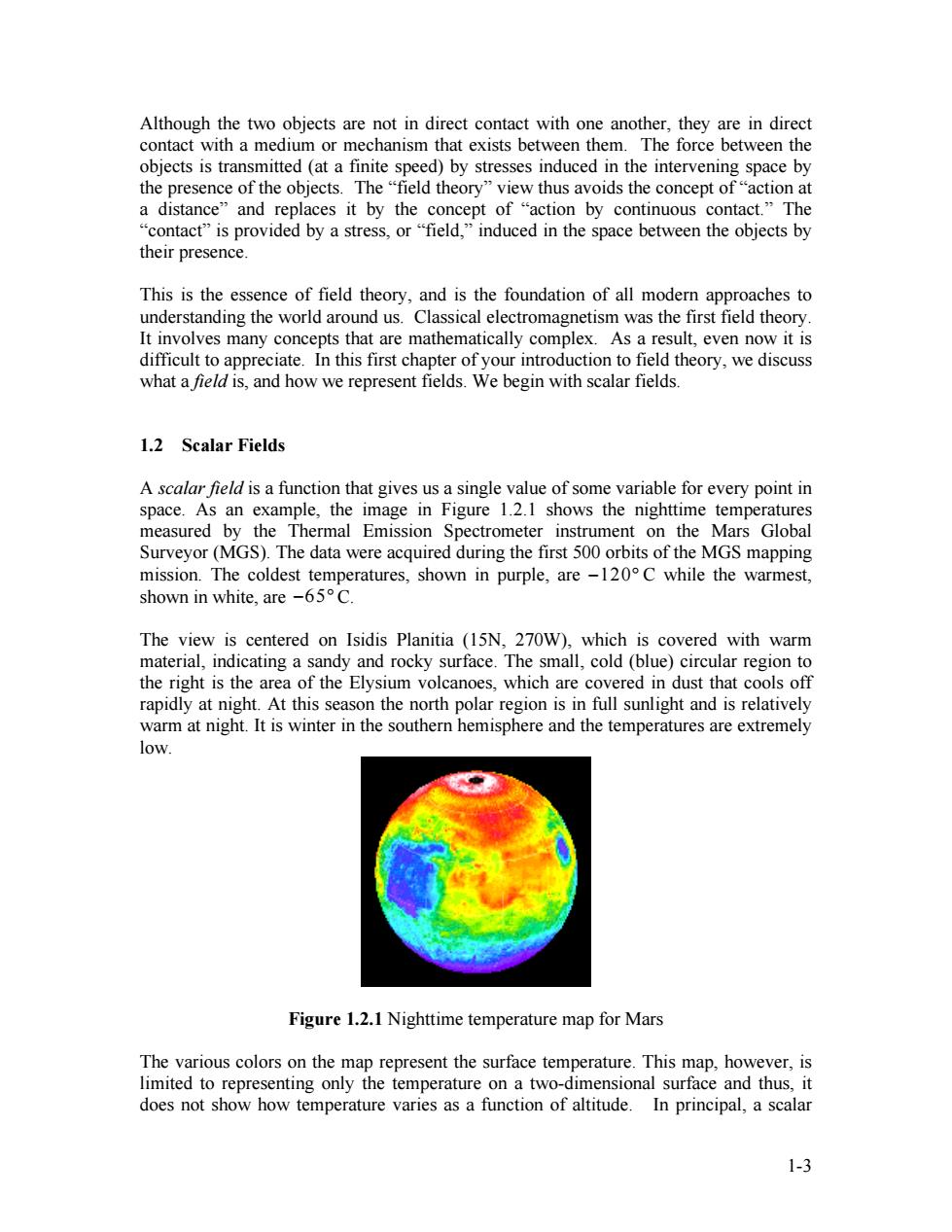正在加载图片...

Although the two objects are not in direct contact with one another,they are in direct contact with a medium or mechanism that exists between them.The force between the objects is transmitted (at a finite speed)by stresses induced in the intervening space by the presence of the objects.The "field theory"view thus avoids the concept of"action at a distance"and replaces it by the concept of "action by continuous contact."The "contact"is provided by a stress,or "field,"induced in the space between the objects by their presence. This is the essence of field theory,and is the foundation of all modern approaches to understanding the world around us.Classical electromagnetism was the first field theory. It involves many concepts that are mathematically complex.As a result,even now it is difficult to appreciate.In this first chapter of your introduction to field theory,we discuss what a field is,and how we represent fields.We begin with scalar fields. 1.2 Scalar Fields A scalar field is a function that gives us a single value of some variable for every point in space.As an example,the image in Figure 1.2.1 shows the nighttime temperatures measured by the Thermal Emission Spectrometer instrument on the Mars Global Surveyor(MGS).The data were acquired during the first 500 orbits of the MGS mapping mission.The coldest temperatures,shown in purple,are -120C while the warmest, shown in white,are -65C. The view is centered on Isidis Planitia (15N,270W),which is covered with warm material,indicating a sandy and rocky surface.The small,cold (blue)circular region to the right is the area of the Elysium volcanoes,which are covered in dust that cools off rapidly at night.At this season the north polar region is in full sunlight and is relatively warm at night.It is winter in the southern hemisphere and the temperatures are extremely low. Figure 1.2.1 Nighttime temperature map for Mars The various colors on the map represent the surface temperature.This map,however,is limited to representing only the temperature on a two-dimensional surface and thus,it does not show how temperature varies as a function of altitude.In principal,a scalar 1-31-3 Although the two objects are not in direct contact with one another, they are in direct contact with a medium or mechanism that exists between them. The force between the objects is transmitted (at a finite speed) by stresses induced in the intervening space by the presence of the objects. The “field theory” view thus avoids the concept of “action at a distance” and replaces it by the concept of “action by continuous contact.” The “contact” is provided by a stress, or “field,” induced in the space between the objects by their presence. This is the essence of field theory, and is the foundation of all modern approaches to understanding the world around us. Classical electromagnetism was the first field theory. It involves many concepts that are mathematically complex. As a result, even now it is difficult to appreciate. In this first chapter of your introduction to field theory, we discuss what a field is, and how we represent fields. We begin with scalar fields. 1.2 Scalar Fields A scalar field is a function that gives us a single value of some variable for every point in space. As an example, the image in Figure 1.2.1 shows the nighttime temperatures measured by the Thermal Emission Spectrometer instrument on the Mars Global Surveyor (MGS). The data were acquired during the first 500 orbits of the MGS mapping mission. The coldest temperatures, shown in purple, are −120° C while the warmest, shown in white, are − ° 65 C. The view is centered on Isidis Planitia (15N, 270W), which is covered with warm material, indicating a sandy and rocky surface. The small, cold (blue) circular region to the right is the area of the Elysium volcanoes, which are covered in dust that cools off rapidly at night. At this season the north polar region is in full sunlight and is relatively warm at night. It is winter in the southern hemisphere and the temperatures are extremely low. Figure 1.2.1 Nighttime temperature map for Mars The various colors on the map represent the surface temperature. This map, however, is limited to representing only the temperature on a two-dimensional surface and thus, it does not show how temperature varies as a function of altitude. In principal, a scalar